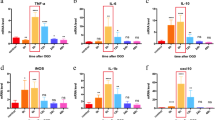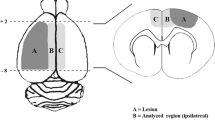Abstract
Macrophage inflammatory protein-3α (MIP-3α) and its sole receptor, CCR6, play pivotal roles in neuroinflammatory processes induced by brain ischemic insults. In this study, we investigated transient ischemia-induced changes in MIP-3α and CCR6 protein expressions in the hippocampal CA1 area following 5 min of transient global cerebral ischemia (tgCI) in gerbils. Both MIP-3α and CCR6 immunoreactivities were very strongly expressed in pyramidal neurons of the CA1 area from 6 h to 1 day after tgCI and were hardly shown 4 days after tgCI. In addition, strong MIP-3α immunoreactivity was newly expressed in astrocytes 6 h after tgCI. These results indicate that tgCI causes apparent changes in MIP-3α and CCR6 expressions in pyramidal neurons and astrocytes in the hippocampal CA1 area and suggest that tgCI-induced changes in MIP-3α and CCR6 expressions might be closely associated with neuroinflammatory processes in brain ischemic regions.





Similar content being viewed by others
References
Kirino T (1982) Delayed neuronal death in the gerbil hippocampus following ischemia. Brain Res 239:57–69
Kirino T, Sano K (1984) Selective vulnerability in the gerbil hippocampus following transient ischemia. Acta Neuropathol 62:201–208
Barone FC, Feuerstein GZ (1999) Inflammatory mediators and stroke: new opportunities for novel therapeutics. J Cereb Blood Flow Metab 19:819–834
Dirnagl U, Iadecola C, Moskowitz MA (1999) Pathobiology of ischaemic stroke: an integrated view. Trends Neurosci 22:391–397
Doyle KP, Simon RP, Stenzel-Poore MP (2008) Mechanisms of ischemic brain damage. Neuropharmacology 55:310–318
Harukuni I, Bhardwaj A (2006) Mechanisms of brain injury after global cerebral ischemia. Neurol Clin 24:1–21
Hossmann KA (2006) Pathophysiology and therapy of experimental stroke. Cell Mol Neurobiol 26:1057–1083
Sallusto F, Baggiolini M (2008) Chemokines and leukocyte traffic. Nat Immunol 9:949–952
Zlotnik A, Yoshie O (2000) Chemokines: a new classification system and their role in immunity. Immunity 12:121–127
Che X, Ye W, Panga L et al (2001) Monocyte chemoattractant protein-1 expressed in neurons and astrocytes during focal ischemia in mice. Brain Res 902:171–177
Dimitrijevic OB, Stamatovic SM, Keep RF et al (2006) Effects of the chemokine CCL2 on blood-brain barrier permeability during ischemia-reperfusion injury. J Cereb Blood Flow Metab 26:797–810
Hurn PD, Subramanian S, Parker SM et al (2007) T- and B-cell-deficient mice with experimental stroke have reduced lesion size and inflammation. J Cereb Blood Flow Metab 27:1798–1805
Kim JS, Gautam SC, Chopp M et al (1995) Expression of monocyte chemoattractant protein-1 and macrophage inflammatory protein-1 after focal cerebral ischemia in the rat. J Neuroimmunol 56:127–134
Schilling M, Strecker JK, Ringelstein EB et al (2009) The role of CC chemokine receptor 2 on microglia activation and blood-borne cell recruitment after transient focal cerebral ischemia in mice. Brain Res 1289:79–84
Chen Y, Hallenbeck JM, Ruetzler C et al (2003) Overexpression of monocyte chemoattractant protein 1 in the brain exacerbates ischemic brain injury and is associated with recruitment of inflammatory cells. J Cereb Blood Flow Metab 23:748–755
Garau A, Bertini R, Colotta F et al (2005) Neuroprotection with the CXCL8 inhibitor repertaxin in transient brain ischemia. Cytokine 30:125–131
Glabinski AR, Ransohoff RM (1999) Chemokines and chemokine receptors in CNS pathology. J Neurovirol 5:3–12
Karpus WJ, Ransohoff RM (1998) Chemokine regulation of experimental autoimmune encephalomyelitis: temporal and spatial expression patterns govern disease pathogenesis. J Immunol 161:2667–2671
Dieu-Nosjean MC, Massacrier C, Homey B et al (2000) Macrophage inflammatory protein 3alpha is expressed at inflamed epithelial surfaces and is the most potent chemokine known in attracting Langerhans cell precursors. J Exp Med 192:705–718
Krzysiek R, Lefevre EA, Bernard J et al (2000) Regulation of CCR6 chemokine receptor expression and responsiveness to macrophage inflammatory protein-3alpha/CCL20 in human B cells. Blood 96:2338–2345
Liao F, Rabin RL, Smith CS et al (1999) CC-chemokine receptor 6 is expressed on diverse memory subsets of T cells and determines responsiveness to macrophage inflammatory protein 3 alpha. J Immunol 162:186–194
Perez-Canadillas JM, Zaballos A, Gutierrez J et al (2001) NMR solution structure of murine CCL20/MIP-3alpha, a chemokine that specifically chemoattracts immature dendritic cells and lymphocytes through its highly specific interaction with the beta-chemokine receptor CCR6. J Biol Chem 276:28372–28379
Klein M, Brouwer MC, Angele B et al (2014) Leukocyte attraction by CCL20 and its receptor CCR6 in humans and mice with pneumococcal meningitis. PLoS ONE 9:e93057
Liu JX, Cao X, Liu Y et al (2016) Altered expression of neuronal CCR6 during pilocarpine induced status epilepticus in mice. Epilepsy Res 126:45–52
Serafini B, Columba-Cabezas S, Di Rosa F et al (2000) Intracerebral recruitment and maturation of dendritic cells in the onset and progression of experimental autoimmune encephalomyelitis. Am J Pathol 157:1991–2002
Subramanian S, Ayala P, Wadsworth TL et al (2010) CCR6: a biomarker for Alzheimer’s-like disease in a triple transgenic mouse model. J Alzheimers Dis 22:619–629
Jaehne EJ, Baune BT (2014) Effects of chemokine receptor signalling on cognition-like, emotion-like and sociability behaviours of CCR6 and CCR7 knockout mice. Behav Brain Res 261:31–39
Terao Y, Ohta H, Oda A et al (2009) Macrophage inflammatory protein-3alpha plays a key role in the inflammatory cascade in rat focal cerebral ischemia. Neurosci Res 64:75–82
Lee CH, Ahn JH, Won MH (2015) New expression of 5-HT1A receptor in astrocytes in the gerbil hippocampal CA1 region following transient global cerebral ischemia. Neurol Sci 36:383–389
Lee CH, Park JH, Yoo KY et al (2011) Pre- and post-treatments with escitalopram protect against experimental ischemic neuronal damage via regulation of BDNF expression and oxidative stress. Exp Neurol 229:450–459
Park JH, Park CW, Ahn JH et al (2017) Neuroprotection and reduced gliosis by pre- and post-treatments of hydroquinone in a gerbil model of transient cerebral ischemia. Chem Biol Interact 278:230–238
Chen BH, Ahn JH, Park JH et al (2017) Transient cerebral ischemia alters GSK-3beta and p-GSK-3beta immunoreactivity in pyramidal neurons and induces p-GSK-3beta expression in astrocytes in the gerbil hippocampal CA1 area. Neurochem Res 42:2305–2313
Zhang H, Park JH, Maharjan S et al (2017) Sac-1004, a vascular leakage blocker, reduces cerebral ischemia-reperfusion injury by suppressing blood-brain barrier disruption and inflammation. J Neuroinflammation 14:122
Lee JC, Park JH, Kim IH et al (2017) Neuroprotection of ischemic preconditioning is mediated by thioredoxin 2 in the hippocampal CA1 region following a subsequent transient cerebral ischemia. Brain Pathol 27:276–291
Yan BC, Ohk TG, Ahn JH et al (2014) Differences in neuronal damage and gliosis in the hippocampus between young and adult gerbils induced by long duration of transient cerebral ischemia. J Neurol Sci 337:129–136
Fujiwara N, Som AT, Pham LD et al (2016) A free radical scavenger edaravone suppresses systemic inflammatory responses in a rat transient focal ischemia model. Neurosci Lett 633:7–13
Zheng Z, Yenari MA (2004) Post-ischemic inflammation: molecular mechanisms and therapeutic implications. Neurol Res 26:884–892
Saito K, Suyama K, Nishida K et al (1996) Early increases in TNF-alpha, IL-6 and IL-1 beta levels following transient cerebral ischemia in gerbil brain. Neurosci Lett 206:149–152
Ohta H, Terao Y, Shintani Y et al (2007) Therapeutic time window of post-ischemic mild hypothermia and the gene expression associated with the neuroprotection in rat focal cerebral ischemia. Neurosci Res 57:424–433
Tounai H, Hayakawa N, Kato H et al (2007) Immunohistochemical study on distribution of NF-kappaB and p53 in gerbil hippocampus after transient cerebral ischemia: effect of pitavastatin. Metab Brain Dis 22:89–104
Yoo KY, Yoo DY, Hwang IK et al (2011) Time-course alterations of Toll-like receptor 4 and NF-kappaB p65, and their co-expression in the gerbil hippocampal CA1 region after transient cerebral ischemia. Neurochem Res 36:2417–2426
Ambrosini E, Columba-Cabezas S, Serafini B et al (2003) Astrocytes are the major intracerebral source of macrophage inflammatory protein-3alpha/CCL20 in relapsing experimental autoimmune encephalomyelitis and in vitro. Glia 41:290–300
Acknowledgements
This research was supported by Basic Science Research Program through the National Research Foundation of Korea (NRF) funded by the Ministry of Education (NRF-2017R1D1A1B03029311), by the Bio & Medical Technology Development Program of the NRF funded by the Korean government, MSIP (NRF-2015M3A9B6066968). and by Basic Science Research Program through the National Research Foundation of Korea (NRF) funded by the Ministry of Education (NRF-2017R1D1A1B03030161).
Author information
Authors and Affiliations
Corresponding authors
Ethics declarations
Conflict of interest
The authors declare that they have no potential conflict of interest.
Statement on the Welfare of Animals
All applicable international, national, and/or institutional guidelines for the care and use of animals were followed.
Rights and permissions
About this article
Cite this article
Park, J.H., Noh, Y., Kim, SS. et al. Time-Course Changes and New Expressions of MIP-3α and Its Receptor, CCR6, in the Gerbil Hippocampal CA1 Area Following Transient Global Cerebral Ischemia. Neurochem Res 43, 2102–2110 (2018). https://doi.org/10.1007/s11064-018-2632-6
Received:
Revised:
Accepted:
Published:
Issue Date:
DOI: https://doi.org/10.1007/s11064-018-2632-6




